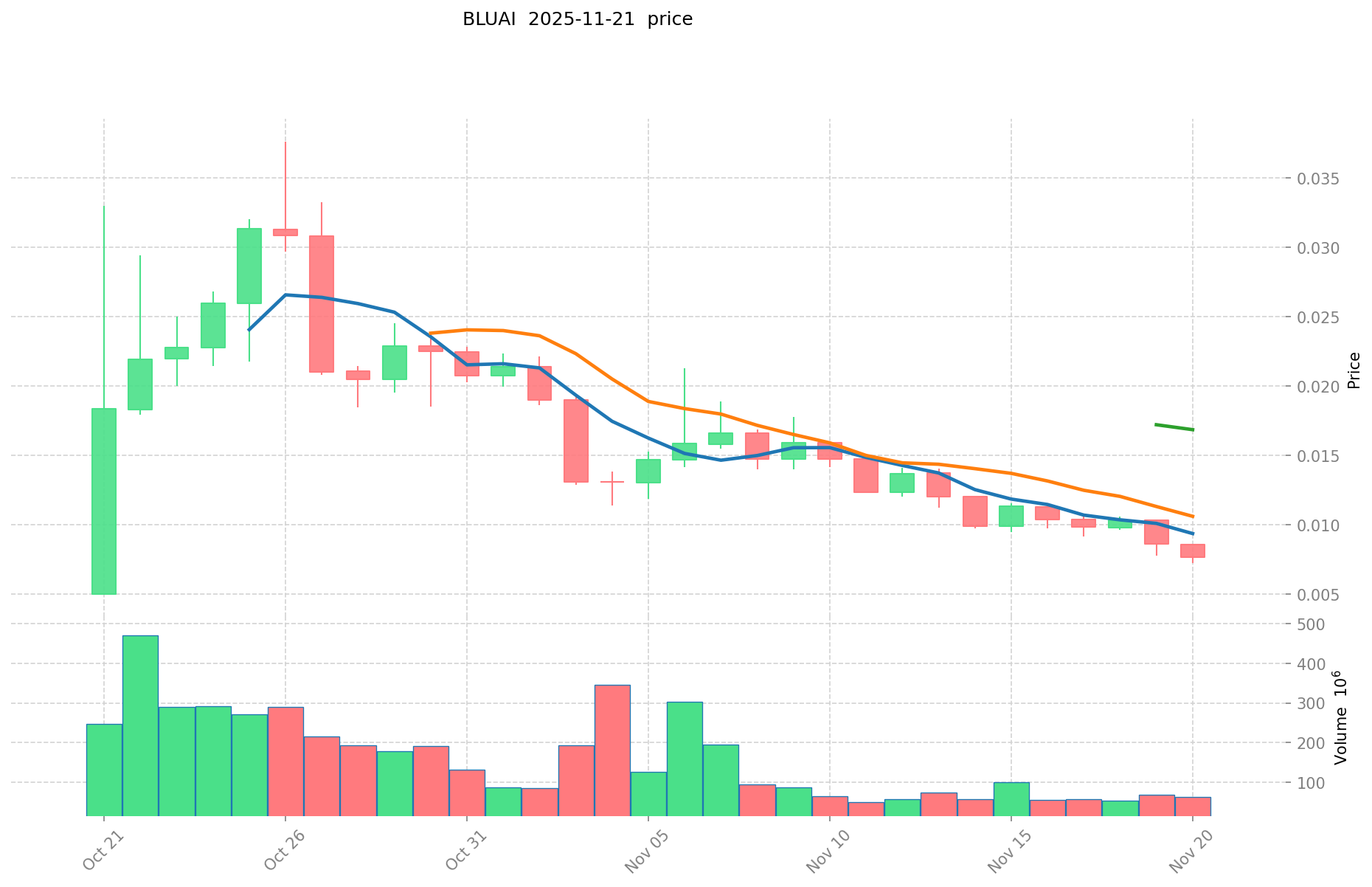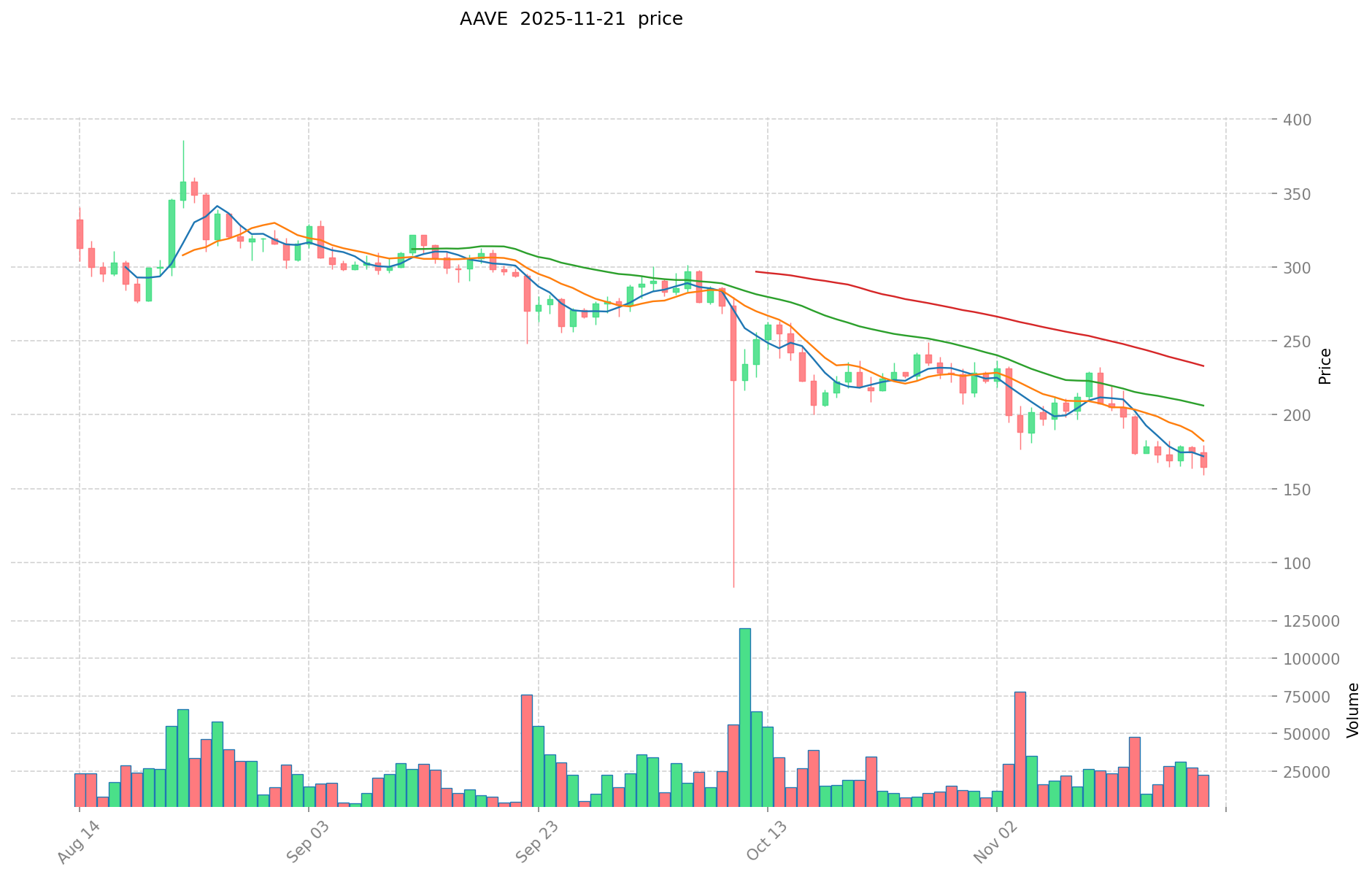BLUAI vs AAVE: Comparing Two Innovative DeFi Protocols in the Crypto Ecosystem
Introduction: Investment Comparison of BLUAI vs AAVE
In the cryptocurrency market, the comparison between BLUAI vs AAVE has been an unavoidable topic for investors. The two not only show significant differences in market cap ranking, application scenarios, and price performance, but also represent different positioning in crypto assets.
BLUAI (BLUAI): Launched in 2025, it has gained market recognition for its role as Web3's Intelligence Layer, providing a decentralized AI network for financial services.
AAVE (AAVE): Introduced in 2020, it has been hailed as a leading decentralized lending protocol, offering deposit and lending services in the DeFi space.
This article will comprehensively analyze the investment value comparison between BLUAI vs AAVE, focusing on historical price trends, supply mechanisms, institutional adoption, technological ecosystems, and future predictions, attempting to answer the question investors care about most:
"Which is the better buy right now?"
I. Price History Comparison and Current Market Status
BLUAI (Coin A) and AAVE (Coin B) Historical Price Trends
- 2025: BLUAI launched its token generation event (TGE) on October 21, with the price starting at a low point.
- 2021: AAVE reached its all-time high of $661.69 on May 19, likely influenced by the overall crypto market bull run.
- Comparative analysis: In the recent market cycle, BLUAI has dropped from its all-time high of $0.03763 on October 26, 2025, to its current price, while AAVE has shown more long-term stability, currently trading well above its all-time low of $26.02 set in November 2020.
Current Market Situation (2025-11-21)
- BLUAI current price: $0.007742
- AAVE current price: $162.69
- 24-hour trading volume: BLUAI $557,099.32 vs AAVE $4,188,617.67
- Market Sentiment Index (Fear & Greed Index): 14 (Extreme Fear)
Click to view real-time prices:
- View BLUAI current price Market Price
- View AAVE current price Market Price


II. Key Factors Affecting the Investment Value of BLUAI vs AAVE
Supply Mechanism Comparison (Tokenomics)
-
BLUAI: Limited maximum supply of 2.1 billion tokens with a deflationary burn mechanism
-
AAVE: Fixed supply of 16 million tokens with staking rewards and safety module
-
📌 Historical Pattern: Deflationary tokens like BLUAI tend to experience price appreciation during periods of increased network usage, while AAVE's fixed supply model provides price stability through governance participation.
Institutional Adoption and Market Applications
- Institutional Holdings: AAVE has stronger institutional backing with established DeFi presence and integration with major protocols
- Enterprise Adoption: AAVE demonstrates wider adoption in lending markets and institutional liquidity provision, while BLUAI focuses on AI applications and decentralized computing resources
- Regulatory Attitudes: AAVE benefits from established regulatory clarity in most jurisdictions as a DeFi pioneer, while BLUAI's AI-focused model faces developing regulatory frameworks
Technical Development and Ecosystem Building
- BLUAI Technical Upgrades: Integration of AI capabilities with blockchain infrastructure, creating a marketplace for decentralized AI computing resources
- AAVE Technical Development: Continuous protocol improvements focused on lending efficiency, security, and cross-chain functionality through V3 implementation
- Ecosystem Comparison: AAVE has an established DeFi ecosystem with widespread integration across lending platforms, while BLUAI is building a specialized ecosystem at the intersection of AI and blockchain technologies
Macroeconomic Factors and Market Cycles
- Performance During Inflation: AAVE tends to maintain stability during inflationary periods due to its established use cases, while BLUAI's performance is more correlated with AI sector growth
- Macroeconomic Monetary Policy: Interest rate changes affect AAVE more directly as a lending protocol, with higher rates potentially reducing borrowing activity
- Geopolitical Factors: AAVE benefits from global DeFi adoption trends, while BLUAI's growth may be impacted by regional AI regulation differences
III. 2025-2030 Price Prediction: BLUAI vs AAVE
Short-term Prediction (2025)
- BLUAI: Conservative $0.00401752 - $0.007726 | Optimistic $0.007726 - $0.0084986
- AAVE: Conservative $89.419 - $162.58 | Optimistic $162.58 - $169.0832
Mid-term Prediction (2027)
- BLUAI may enter a growth phase, with expected prices ranging from $0.008031177 to $0.0098564445
- AAVE may enter a steady growth phase, with expected prices ranging from $160.87323516 to $222.33042612
- Key drivers: Institutional capital inflow, ETF, ecosystem development
Long-term Prediction (2030)
- BLUAI: Base scenario $0.0130753402416 - $0.01895924335032 | Optimistic scenario $0.01895924335032+
- AAVE: Base scenario $240.491703885345 - $247.70645500190535 | Optimistic scenario $247.70645500190535+
Disclaimer
BLUAI:
| 年份 | 预测最高价 | 预测平均价格 | 预测最低价 | 涨跌幅 |
|---|---|---|---|---|
| 2025 | 0.0084986 | 0.007726 | 0.00401752 | 0 |
| 2026 | 0.010140375 | 0.0081123 | 0.004786257 | 4 |
| 2027 | 0.0098564445 | 0.0091263375 | 0.008031177 | 17 |
| 2028 | 0.01176932484 | 0.009491391 | 0.00484060941 | 22 |
| 2029 | 0.0155203225632 | 0.01063035792 | 0.009035804232 | 37 |
| 2030 | 0.01895924335032 | 0.0130753402416 | 0.0098065051812 | 68 |
AAVE:
| 年份 | 预测最高价 | 预测平均价格 | 预测最低价 | 涨跌幅 |
|---|---|---|---|---|
| 2025 | 169.0832 | 162.58 | 89.419 | 0 |
| 2026 | 195.681288 | 165.8316 | 160.856652 | 1 |
| 2027 | 222.33042612 | 180.756444 | 160.87323516 | 11 |
| 2028 | 231.774950319 | 201.54343506 | 120.926061036 | 23 |
| 2029 | 264.32421508119 | 216.6591926895 | 201.493049201235 | 33 |
| 2030 | 247.70645500190535 | 240.491703885345 | 129.8655200980863 | 47 |
IV. Investment Strategy Comparison: BLUAI vs AAVE
Long-term vs Short-term Investment Strategies
- BLUAI: Suitable for investors focused on AI and blockchain integration potential
- AAVE: Suitable for investors seeking stability and established DeFi exposure
Risk Management and Asset Allocation
- Conservative investors: BLUAI: 10% vs AAVE: 90%
- Aggressive investors: BLUAI: 30% vs AAVE: 70%
- Hedging tools: Stablecoin allocation, options, cross-currency portfolios
V. Potential Risk Comparison
Market Risks
- BLUAI: Higher volatility due to newer market position and AI sector fluctuations
- AAVE: Exposure to overall DeFi market trends and interest rate sensitivity
Technical Risks
- BLUAI: Scalability, network stability, AI integration challenges
- AAVE: Smart contract vulnerabilities, liquidity risks
Regulatory Risks
- Global regulatory policies may have different impacts on AI-focused tokens (BLUAI) versus established DeFi protocols (AAVE)
VI. Conclusion: Which Is the Better Buy?
📌 Investment Value Summary:
- BLUAI advantages: Potential growth in AI-blockchain integration, deflationary tokenomics
- AAVE advantages: Established market position, institutional adoption, ecosystem integration
✅ Investment Advice:
- New investors: Consider a smaller allocation to BLUAI for exposure to AI-blockchain potential, with a larger position in AAVE for stability
- Experienced investors: Balance portfolio with both tokens, adjusting based on risk tolerance and market trends
- Institutional investors: AAVE may be more suitable due to its established presence and regulatory clarity
⚠️ Risk Warning: The cryptocurrency market is highly volatile. This article does not constitute investment advice. None
VII. FAQ
Q1: What are the main differences between BLUAI and AAVE? A: BLUAI is a newer token focused on AI and blockchain integration, while AAVE is an established decentralized lending protocol in the DeFi space. BLUAI has a deflationary tokenomics model with a maximum supply of 2.1 billion tokens, while AAVE has a fixed supply of 16 million tokens. AAVE has stronger institutional backing and wider adoption, whereas BLUAI is building a specialized ecosystem at the intersection of AI and blockchain technologies.
Q2: Which token has performed better historically? A: AAVE has shown more long-term stability and is currently trading well above its all-time low set in November 2020. BLUAI, being newer, has less historical data but has dropped from its all-time high set in October 2025.
Q3: How do the future price predictions compare for BLUAI and AAVE? A: By 2030, BLUAI's base scenario predicts a range of $0.0130753402416 - $0.01895924335032, while AAVE's base scenario predicts $240.491703885345 - $247.70645500190535. BLUAI shows higher potential percentage growth due to its lower starting price and emerging technology focus.
Q4: What are the key risk factors for each token? A: BLUAI faces higher volatility due to its newer market position and AI sector fluctuations, as well as technical risks related to scalability and AI integration. AAVE is exposed to overall DeFi market trends, interest rate sensitivity, and potential smart contract vulnerabilities.
Q5: How might institutional investors view BLUAI vs AAVE? A: Institutional investors may find AAVE more suitable due to its established presence, regulatory clarity, and integration with major protocols. BLUAI might be considered a higher-risk, potentially higher-reward option for those looking to invest in AI-blockchain integration.
Q6: What allocation strategy is recommended for different types of investors? A: Conservative investors might consider allocating 10% to BLUAI and 90% to AAVE, while aggressive investors might opt for 30% BLUAI and 70% AAVE. New investors are advised to have a smaller allocation to BLUAI for exposure to AI-blockchain potential, with a larger position in AAVE for stability.
Q7: How do macroeconomic factors affect these tokens differently? A: AAVE tends to maintain stability during inflationary periods due to its established use cases and is more directly affected by interest rate changes as a lending protocol. BLUAI's performance is more correlated with AI sector growth and may be impacted by regional AI regulation differences.
Share
Content